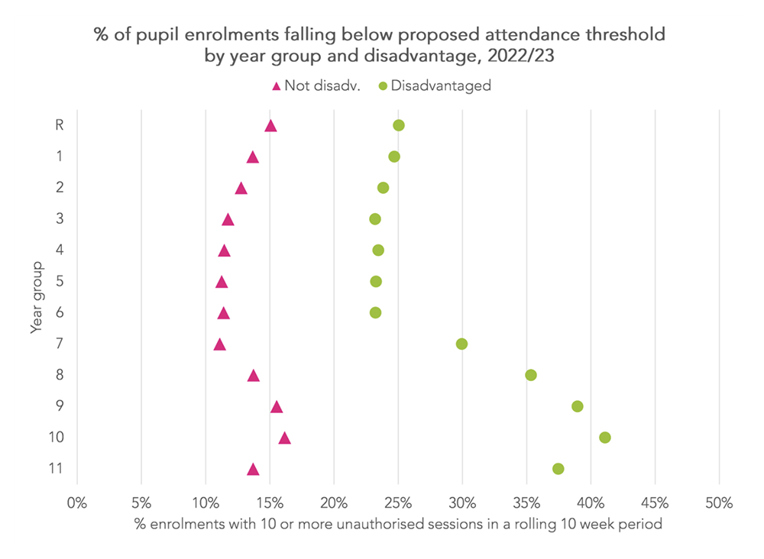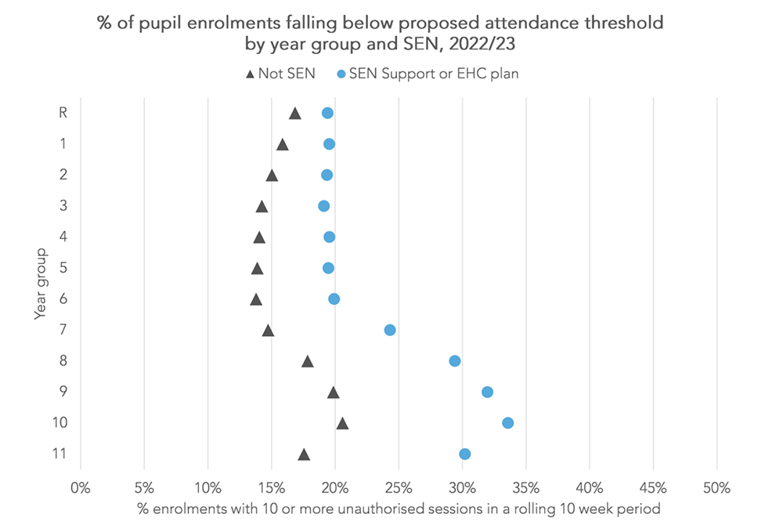
A national framework for parental fines is being introduced from September with fines of £80 for any pupil who misses 10 or more half-days within any 10-week period.
An analysis published this week (Bibby & Thomson, 2024) and based on attendance data from almost 10,000 schools considered the number of pupils who would have broken this new threshold in 2022/23.
While the results show that the bulk of fines would have been given to secondary-age pupils, at primary level 15% of primary pupils would have broken the threshold in years 3 to 6, with a slightly higher proportion being fined in years 1 and 2. The highest rate of fines would have been in Reception (around 17%).
And around 6% to 7% of pupils across all primary year groups would have broken the threshold more than once.
But it is when you factor in SEN and disadvantage that the picture of just who will be getting fined becomes stark.
When it comes to pupils on free school meals, between 23% and 25% of primary pupils would have been fined in 2022/23 compared to between 11% and 16% of their non-disadvantaged peers (depending on the year group).
The same story is told for pupils with SEN: around 20% of primary pupils across the year groups would have been fined compared to around 14% to 16% of their non-SEN peers (depending on the year group).


Unfair fines? The analysis from FFT Education Datalab shows that both SEND students and those on free school meals will be among the hardest hit by the new £80 fines and absence thresholds (source: Bibby & Thomson, 2024)
The analysts warn that their figures are likely to be an underestimate as the data is for 2022/23 alone and doesn’t consider any 10-week periods that overlap with previous or subsequent academic years.
The DfE said that its new national framework will “tackle inconsistencies” in the use of fines across the country.
The framework will be introduced from September when the Working together to improve school attendance guidance will become statutory.
The new rules still give schools and local authorities discretion, although while this means fines might not be issued in every case, it also means fines can be issued even before the new threshold is met.
The guidance requires that schools take “a support-first approach to help pupils and their families to tackle barriers to attendance”. Expectations include regular meetings between schools and local authorities to agree plans for the most at-risk absent children.
The DfE adds: “It particularly emphasises the importance of support for pupils with SEND and mental ill-health who often need more individual consideration due to wider barriers. It asks schools, local authorities and wider services to work together to support these pupils, encouraging early intervention and close working with families to address their individual needs.”
Also under the new guidance, all state schools in England will be required to share their daily attendance registers. The DfE wants this information to form a “new world-leading attendance dataset” which it says will help schools and others to identify absence trends.
Schools, trusts and councils will be able to access this data via an “interactive secure data dashboard” which is to be maintained by the DfE.
Commenting this week, Paul Whiteman, general secretary of the National Association of Head Teachers, said: “Fines have long proven to be too blunt a tool and largely ineffective at improving persistent absence.
“What is really needed to tackle poor attendance is more targeted resources to find out the reasons behind absence, including support for vulnerable families and for children and young people’s mental health. Without that work, higher fines could just be further punishing already struggling families and children.”
Mr Whiteman added: “When it comes to schools sharing attendance data, it is important to remember that the overwhelming majority of schools already do this.”
- DfE: Guidance: Working together to improve school attendance, February 2024: www.gov.uk/government/publications/working-together-to-improve-school-attendance
- Bibby & Thomson: How many pupils are at risk of falling below the proposed new thresholds for attendance? FFT Education Datalab, March 2024: https://ffteducationdatalab.org.uk/2024/03/how-many-pupils-are-at-risk-of-falling-below-the-proposed-new-thresholds-for-attendance/
